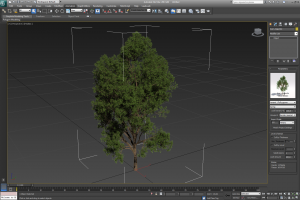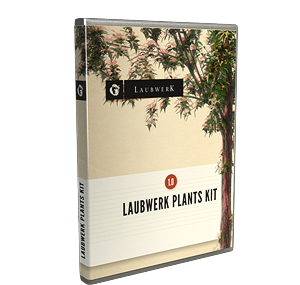
Modern villa on the Adriatic, CG artwork by Kizo, using Cinema 4D, Corona Renderer, and Laubwerk Plant Kit 22
Laubwerk Plant Kit 22 – Temperate Ornamental Perennials
The following ten temperate flowering ornamental species and cultivars are included in Plant Kit 22. Each species or cultivar comes in three variations, in one season (full bloom), for a total of thirty models per kit. Note that this is a pre-release edition of Kit 22 with only one season. It is therefore offered at a reduced price.
Includes Thirty Models
All Laubwerk plants in this kit come in three variations in one season per species or cultivar.
Overview of the ten species and cultivars included in Laubwerk Plant Kit 22.


Detail of Japanese anemone 'Bressingham Glow' (Eriocapitella japonica 'Bressingham Glow')

Detail of lily of the valley (Convallaria majalis)

Detail of Leopard's bane (Doronicum orientale)

Detail of cranesbill 'Hocus Pocus' (Geranium pratense 'Hocus Pocus')
Includes Free Laubwerk Player
 The Laubwerk Player is a plugin for Autodesk 3ds Max, Maya, Maxon Cinema 4D, or SketchUp that comes bundled with every Laubwerk Plant Kit. It loads the models and allows for easy selection and manipulation of the models, e.g. choose between variations, ages and seasons and allows fine grained control about Level of Detail. See the Laubwerk Player page for a more detailed description.
The Laubwerk Player is a plugin for Autodesk 3ds Max, Maya, Maxon Cinema 4D, or SketchUp that comes bundled with every Laubwerk Plant Kit. It loads the models and allows for easy selection and manipulation of the models, e.g. choose between variations, ages and seasons and allows fine grained control about Level of Detail. See the Laubwerk Player page for a more detailed description.
Price and Licensing
- 'Per Artist' license
- Attractive pricing per Kit, e.g. single user 149€ (w/o VAT), two users 249€, etc.
- Additional render nodes are free of charge
Customer Support
Laubwerk Customer Support includes technical support by email and free periodic updates for bug fixes and improvements of the Laubwerk Plant models. Your purchases are delivered as direct downloads.
Free Updates
Laubwerk products are constantly being updated with the latest technology. Keep your Plant Kit up-to-date! To update your Laubwerk Plant Kit(s), log in to your Account Page and download the latest update.
Free Trial
For a free product trial get the Laubwerk Plant Kit Freebie.
System Requirements
- Autodesk 3ds Max (2015-2025), Autodesk Maya (2018-2024, Win & Mac, Linux on request), MAXON Cinema 4D (R18-26, 2023, Mac & Win), Trimble SketchUp (2014-2024, Mac & Win) with V-Ray for SketchUp or Thea Render for SketchUp, and Vectorworks 2023 (or newer).
- Additionally, Python for customers to build their own importers into applications compatible with Python for Windows 2.7, 3.3- 3.4, MacOS X 3.5-3.8, Linux 3.4-3.8.
- A computer that is capable of running your version(s) of 3ds Max, Maya, Cinema 4D, or SketchUp.
- 10MB of hard disk space and additional space for the Laubwerk Plants models.
Installation Instructions
Our aim is to make the installation process as easy as possible for you. If you like to get more information, we have compiled these Laubwerk Plant Kits installation instructions, including advanced topics such as considerations when working in a network.

